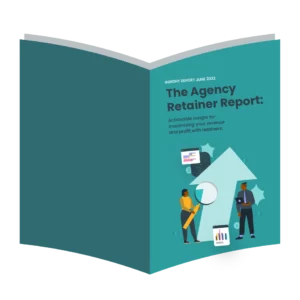One of the biggest challenges agencies face is the need to constantly prove ROI to their clients. This becomes particularly apparent in the context of retainers. While a retainer-focused business model can provide valuable revenue certainty for agencies, the variety of services they often include can make them slightly more complicated to justify.
Often, retainers will contain work that mostly goes on ‘behind the scenes’ alongside more visible customer-facing services. The value of this ‘hidden’ work is obvious to the agencies working on delivering the retainer, but can be harder to prove to the end-client. This can obviously cause roadblocks, revenue issues, and complicate a pipeline of ongoing work.
We spoke to accountant and agency expert Paul Barnes to learn more about the best way for agencies to prove the ROI of their retainers, and thereby secure more recurring revenue and confidence from their end-customers.
The accountancy view
Paul Barnes is Managing Director of MAP, who specialises in helping digital creative agencies grow more profitably by giving them total visibility and understanding of their finances. Paul’s experience working with agencies has led him to a deeper understanding of how those agencies operate – especially in terms of their revenue management.

We spoke to him in order to gain his insight for our report on agency retainer use, during which he identified the struggle with proving ROI as a major issue currently being faced by agencies.
It’s even more apparent in light of their otherwise increasing financial confidence. Paul suggests that having survived the pandemic, “Agencies are becoming more engaged with finance”. “People feel more financially intelligent,” as a result of successfully guiding their businesses through the recent tumultuous times.
This increased confidence has led agencies to focus more on areas of potential business growth, which means that they need a clearer view of their future revenue as well as their current finances. This, Paul says, is where retainers come in. “One of their biggest benefits, which people don’t recognise enough, is the ability to forecast – and therefore plan the resources required for your business,” explains Paul. They allow agencies to “build an easier, simpler, more lucrative business that doesn’t require you to go out hustling and winning new work all the time.”
Given the pandemic’s upheaval of business, and the resulting need to become more financially literate, it’s no surprise that many agencies are looking to optimise their retainers.

Make the most of your agency’s retainers.
Use our insight report to help you reimagine your retainers and raise your profits.The challenges with proving ROI
In the simplest possible terms, ROI refers to a simple calculation that weighs the investment cost against the benefits an investor receives as a result of that cost. It’s a metric used to understand the profitability of an investment – and so it is this measurement, profitability, that agencies must work to prove. It is often the chief consideration in play when attempting to secure a retained relationship with a client. But look up ROI, and you’ll find many of the top search results are offering help with how to go about proving it. Clearly, this is a struggle faced by many.
For agencies working with retainers, it’s even more complicated; they not only have to prove the profitability of the initial project, but also that of ongoing, regular work. According to Paul, the ways in which clients understand the costs of a retainer can have an effect on the way they perceive its value. Historically, a popular way for agencies to charge for retainers is based on the time taken to deliver them. However, as Paul suggests, tying a retainer package to the time spent on its delivery is, “a big mistake, because then you’re instantly open to scrutiny.”
And, although time is spent on their delivery, it is not the best metric to measure certain retained services, such as content management or web hosting, for example. But if you shouldn’t structure your retainers in terms of time spent, how should you structure your pricing model to show the most deliverable value for an end-client?
How to solve ROI challenges
“Retainers have to be credible,” Paul says. “Do your clients see the value?”.
This – the reframing of your retainers to better establish value from the clients’ perspectives – is Paul’s largest piece of advice for agencies struggling with proving the ROI of their services. “Being clever, and finding a way to tie the price into something that makes sense to the customer,” he says, is the best way to approach the pricing of a retainer.
Your customer doesn’t really care how much time has gone into something that they’re paying for – they care about value. So it’s coming up with productised pricing that makes the most sense – the perceived value to the customer is key.
Paul Barnes, Managing Director of MAP
This so-called ‘productised pricing’ is easier for some agency industries to pivot to than others – Paul identifies app developers as one example of a business more suited to a project approach.
But, he continues, for most agencies it is simply a matter of “positioning it differently”. As long as you can communicate your services in a way which frames them as being in the best interest of your end-customer, you’re more likely to succeed at delivering an ROI without challenges. The main question you should be asking yourself? “How can you make a more realistic experience for your customers?”
The best route to profitable retainers
Retainer-based business structures are hugely beneficial to agencies who operate them successfully. They allow an element of revenue certainty, which in turn gives agencies freedom to make changes and decisions with the knowledge that their turnover is protected.
Of course, those retainers are only as valuable as the end-customer believes them to be. That’s where it becomes vital to reframe them to establish a strong ROI. “Put yourself in your customer’s shoes and work out something that delivers value to both of you, and come away from that mindset that everything has to be about time for money,” Paul says. In this way, agencies can reframe their services, confidently assert the ROI on their retainers, and secure revenue certainty for the future.

